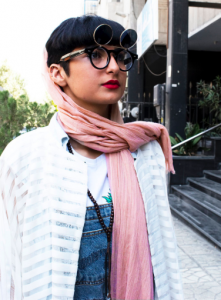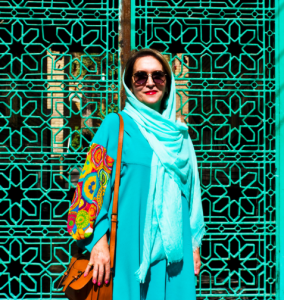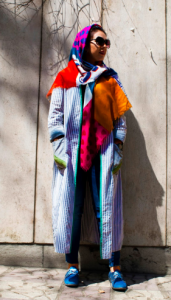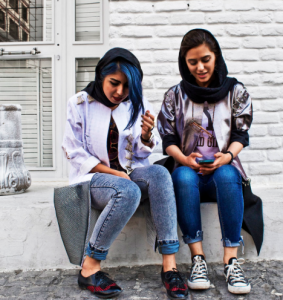Hoda Katebi and JooJoo Azad
“JooJoo Azad is a radical anti-capitalist, intersectional feminist, and body-positive political fashion platform written and run by Hoda Katebi, a sarcastic (& angry) Muslim-Iranian creative and community organizer living in Chicago.” —JooJoo Azad
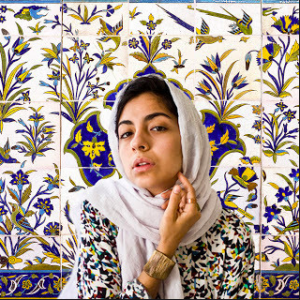
Hoda Katebi runs the blog JooJoo Azad and her feminism is as intersectional as it gets. Her work centers around race and gender while bringing in intersections of religion, Western colonialism/imperialism, and militarization, which are often left out of feminist conversations in the West.
* This blog post by Katebi has a list of vocabulary words, such as imperialism, which may be helpful in understanding this post. Although I will be defining terms and linking articles as we go along :)*
1. Fashion is Political
The fashion industry is dominated by women, so in the eyes of the patriarchy, it is not perceived as something of political value. Instead, fashion is often seen as vain and materialistic. Katebi argues that this is a sexist and patriarchal view of fashion. Not only is fashion an art form of expression, but something we use every day. It is one of the most powerful and intimate industries in the world.
If there is one message to understand from Hoda’s work, it is fashion is political. There is no working around it. When you are wearing clothing, you are either advocating a political message or having the privilege not to send one. These messages are not always something that should be politicized. For example, a Muslim woman wearing a hijab or a student breaking the “fingertip rule”, by not wearing a skirt 3 inches longer than their fingertips. Other political messages are chosen, such as wearing a shirt that says, “Capitalism Kills”. Even if you think you are not sending a political message, you are participating through silence or indifference. For example, by wearing a plain green t-shirt with jeans, you are exercising your privilege not to politically interfere, allowing oppression and injustice to continue.
In addition, where your clothes are made and who makes them is political, but we will get to that in #4.
2. White Western Colonial “Feminism” and the Hijab
Katebi, being Iranian American, focuses her work on Iranian fashion, both in the United States and Iran. Due to the extreme politicizing and obsession of the hijab by the white Western world, the politics surrounding the hijab is a topic Katebi speaks about often. However, the hijab is not something that should be political. It is a woman’s personal choice to wear or not wear the hijab, and is frankly, none of your business.
The hijab and other forms of veiling by Muslim women is used as an excuse for American military intervention, such as the ongoing conflicts in Iran and the Middle East. These actions are justified through colonial “feminism”, which labels the veil as a symbol of oppression to use as a means to continue war, colonial and imperial projects by the United States, all under the name of “saving” Muslim women who veil. This equates any form of veiling or covering one’s body as oppression and follows the patriarchal thought of controlling women’s bodies and what they wear.
Not only does this take away Muslim women’s autonomy, but American military intervention is not “saving” but harming Muslim women through bombing and sanctions in the Middle East, and military surveillance in the United States. In actuality, the real reason for United States government intervention is often around oil, guns and the international drug trade amongst other political, capitalist and imperialist ventures.
“The over-emphasis on the hijab as synonymous to the Muslim identity essentializes and flattens what it means to be Muslim and allows the Muslim identity therefore to be easily appropriated and exploited for social, political, and economic benefit.”–JooJoo Azad
The feminist text Do Muslim Women Really Need Saving by Laila Abu-Lughod is an AWESOME 8-page article and talks about a few historical and social choices for veiling such as class status and de-sexualizing the body from a male gaze. In addition, some Muslim women do not wear the hijab or any kind of veil. Contrary to patriarchal thought, Muslim women choose what to do with their own bodies, including which clothes they wear. This comes as a surprise to colonial “feminists” when they see women continuing to veil in places where there are no fashion constrictions like in the United States. She also urges Western men and women to move beyond “freeing” women who veil.
“We may want justice for women, but can we accept that there might be different ideas about justice and that different women might want, or choose, different futures from what we envision as best,” –Do Muslim Women Really Need Saving? pg.787-788
3. Non-Gender Binary Iranian Fashion
There are a lot of styles going on in addition to the hijab in the Iranian fashion scene. In fact, there is so much depth and variety, Katebi made a book about it. It’s called Tehran Streetstyle. One goal of this book is to challenge the orientalist view of Iranian fashion. The orientalist view deems anything in East (Middle East/North Africa/South Asia and Islam) as backwards, barbaric and dark while seeing everything in the West (United States, Canada and Europe) as progressive, civilized and light. Orientalism plays a huge role in the idea of “saving” Middle Eastern women, which genders the East as a highly sexual, submissive and voiceless place with women who need to be saved and dominated by the West. Yeah, this has patriarchy written all over it.
Katebi’s book shatters this message, showing “The Underground” fashion scene in Tehran, with vibrant and colorful pictures of men and women’s street style today. Here are some pictures from her book:
“The Underground” is a term for the slow-fashion scene in Iran where unique, high quality, and individually tailored clothes often defy the Iranian government’s mandatory dress codes. Originally, these dress codes were created after the Iranian Revolution in 1979 to fight Westernization and preserve national identity. They were also established to create a classless public framework, as clothing shows off a person’s class level. However, while these dress codes are often not enforced, most Iranian women do not support any government which decides what a person can or cannot wear, which they consider patriarchal and un-Islamic. This includes the Iranian government and ones such as France, who restrict women from veiling under the name of secularism (not showing preference towards a religion).
Non-gender conforming clothing has been part of Iranian fashion for centuries. In the Qajar Dynasty (1789-1925), gender and sexual fluidity were the norm. Actually, the most desirable form of beauty was looking like a prepubescent boy.
Check out this video to hear Katebi talk about the history of gender in Iran:
Katebi also talks about how time is cyclical and not linear, meaning time repeats itself. While fashion has shifted due to contact with the West in the 19th century, Katebi describes “The Underground” as a response to reclaiming a gender fluid identity in Iranian fashion. As you can see in her book, men and women’s clothing is interchangeable, yet influenced by fashion all over the world to create a modern Tehran style.
“Fashion is being used as a powerful tool for challenging gender norms. And it’s beautiful.”–JooJoo Azad
4. Fast-Fashion is Never Feminist
As a feminist fashion blog, Katebi is adamant that All Fast-Fashion Requires Systemic Gender-Based Violence. Remember when I mentioned where and who makes your clothing is political? The majority of the clothes we buy are made by poor women of color in sweatshops all around the world, including the United States, and the working conditions are horrible.
In order to keep up with the Western capitalist demands of production, fast-fashion companies such as Gap, Forever-21, and H&M amongst many others push workers to meet the impossible demands of the fast-fashion industry, producing garments for as fast and cheap as possible. For example, a Walmart supply chain in Bangladesh demands that sweatshop workers make 1 or more items a minute.
If workers are not meeting these requirements, women are subject to gender-based violence such as dehumanizing verbal, emotional and physical abuse, sexual assault, and rape. If this violence is reported, women can be fired, receive threats or become blackmailed from working at other factories. In addition, workers are almost always underpaid. The only reason that we are able to buy a t-shirt for $5 is because the women who made it are being paid $5 a day. This is not just once in a while, this is every day.
“These experiences sit at the intersections of particularities of class, gender, and race: the abuse female garment workers face is no isolated accident. Garment factories exist in nations of color due to the legacies of colonialism, and are systematically dependent on exploitation and gender-based abuse to function within the fast-fashion model of production.”–JooJoo Azad
According to a Gender Labor Justice report, gendered hiring practices are common, which means that women are dominant in fast-fashion factories. The report noted that in the South and South East Asian garment workforce, 95% of the workers are women. This is contextualized in Evelyn Hu-DeHart’s, “Surviving Globalization”, which focuses on American immigrant sweatshop workers. She describes this gendered hiring as sexist assumptions writing,
“Nimble fingers” and “bootstrap” myths have emerged to justify the intense exploitation of Third World women…and immigrant women in the global core…these women are characterized as inherently, innately and naturally suited for the kind of low-skill labor needed in light manufacturing, whether in Third World export-processing factories or in U.S. electronic plants and sweatshops,” –Surviving Globalization pg. 91
The fabric your clothing is made from is also problematic. Just because a company labels their clothing “fair-trade” or “organic cotton” does not make their brand ethical, environmentally friendly or void of gender violence. For example, Victoria’s Secret uses “organic cotton” which was picked by child labor from the company Burkina Faso. Katebi asks us to really think about what it means to have this kind of violence rubbing against our skin every day.
Listen to this podcast by Identity Politics ,where Hoda Katebi is interviewed about fast-fashion, you will not regret it.
How can we avoid economically supporting these classist, sexist, racist and colonialist clothing brands?
Katebi advocates for choosing an ethical and minimalist wardrobe. Why minimalist? On one hand, ethical clothing brands are great, but usually very expensive and only in the reach of middle to upper class women. By taking on a minimalist wardrobe, you can buy a few well-made ethical clothing pieces, similar to the slow-fashion scene of The Underground. However, if you cannot afford this, you can choose to buy fast-fashion brands, but just buy less. This way you can afford your favorite clothing and support fast-fashion as minimally as possible.
To help you along this anti-fast fashion journey, Katebi has made an ongoing Boycott List for brands to avoid and writes various articles about fashion brands that are Katebi approved:
Written by Ella Panchot
Works Cited:
Abu‐Lughod, Lila. “Do Muslim Women Really Need Saving? Anthropological Reflections on Cultural Relativism and Its Others.” AnthroSource, American Anthropological Association, Sept. 2002.
Admin. “Episode 56: The Fabric of Our Lives (Ft. Hoda Katebi).” Identity Politics Podcast, 17 Dec. 2019, identitypoliticspod.com/2019/12/17/episode-56-the-fabric-of-our-lives-ft-hoda-katebi/.
Chicago magazine. 5 Questions Hoda Katebi Is Tired of Answering. YouTube, 18 Apr. 2018, youtu.be/oEMYHaHkegM.
Gender Based Violence in the H&M Garment Supply Chain WORKERS VOICES FROM THE GLOBAL SUPPLY CHAIN : A Report to the ILO 2018. 2018, www.globallaborjustice.org/wp-content/uploads/2018/05/GBV-HM-May-2018.pdf.
Hu-DeHart, Evelyn. “Surviving Globalization Immigrant Women Workers in Late Capitalist America.” Women’s Labor in the Global Economy: Speaking in Multiple Voices, edited by Sharon Harley, Rutgers University Press, 2007, pp. 85–102.
Katebi, Hoda. “ABOUT.” JOOJOO AZAD | جوجو آزاد, JOOJOO AZAD | جوجو آزاد, 2020, www.joojooazad.com/p/about.html.
Katebi, Hoda. Blue Tin Production: Clothing Manufacturing Co-Op Run by Refugee & Immigrant Women! YouTube, 24 Jan. 2019, youtu.be/Kk35hFiJQr0.
Katebi, Hoda. “BOYCOTT LIST.” JOOJOO AZAD | جوجو آزاد, JOOJOO AZAD | جوجو آزاد, www.joojooazad.com/p/boycott-list.html.
Katebi, Hoda. “JOOJOO AZAD: جوجو آزاد.” JOOJOO AZAD | جوجو آزاد, JOOJOO AZAD: جوجو آزاد, 2020, www.joojooazad.com/.
Katebi, Hoda. “JOOJOO AZAD: جوجو آزاد: 4 Things You Need to Know about Police, Militarization, and Islamophobia.” JOOJOO AZAD | جوجو آزاد, JOOJOO AZAD | جوجو آزاد, 18 Oct. 2016, www.joojooazad.com/2016/10/police-militarization-islamophobia.html.
Katebi, Hoda. “JOOJOO AZAD: جوجو آزاد: 4 WOMEN-POWERED PALESTINIAN BRANDS THAT ARE TOTALLY KILLING THE FASHION GAME.” JOOJOO AZAD | جوجو آزاد, JOOJOO AZAD | جوجو آزاد, 14 Oct. 2015, www.joojooazad.com/2015/10/women-powered-palestinian-fashion-brands.html.
Katebi, Hoda. “JOOJOO AZAD: جوجو آزاد: 6 (ETHICAL) STORES YOU’LL LOVE AS MUCH AS ZARA.” JOOJOO AZAD | جوجو آزاد, JOOJOO AZAD | جوجو آزاد, 24 Mar. 2015, www.joojooazad.com/2015/03/6-ethical-stores-youll-love-as-much-as-zara.html.
Katebi, Hoda. “JOOJOO AZAD: جوجو آزاد: 6 NEW ONLINE (ETHICAL) BRANDS YOU’LL LOVE.” JOOJOO AZAD | جوجو آزاد, JOOJOO AZAD | جوجو آزاد, 17 Dec. 2016, www.joojooazad.com/2016/12/6-new-online-ethical-brands-youll-love.html.
Katebi, Hoda. “JOOJOO AZAD: جوجو آزاد: All Fast-Fashion Requires Systemic Gender-Based Violence: Conscious Collections Are Fake News.” JOOJOO AZAD | جوجو آزاد, JOOJOO AZAD | جوجو آزاد, 5 July 2018, www.joojooazad.com/2018/07/ethical-fast-fashion-gender-based-violence-in-factories.html.
Katebi, Hoda. “JOOJOO AZAD: جوجو آزاد: FEMINISM, ORIENTALISM, ASRA NOMANI, AND THE HIJAB: AN OPEN LETTER.” JOOJOO AZAD | جوجو آزاد, JOOJOO AZAD | جوجو آزاد, 2 June 2016, www.joojooazad.com/2016/06/feminism-orientalism-asra-nomani-and-hijab.html.
Katebi, Hoda. “JOOJOO AZAD: جوجو آزاد: FROM FASHION TO WAR: BREAKING DOWN ORIENTALISM.” JOOJOO AZAD | جوجو آزاد, JOOJOO AZAD | جوجو آزاد, 29 May 2017, www.joojooazad.com/2017/05/fashion-to-war-orientalism-spark-notes.html.
Katebi, Hoda. “JOOJOO AZAD: جوجو آزاد: If You Use Our Faces Maybe Stop Killing Our People?” JOOJOO AZAD | جوجو آزاد, JOOJOO AZAD | جوجو آزاد, 5 Mar. 2017, www.joojooazad.com/2017/03/if-you-use-our-faces-maybe-stop-killing-our-people.html.
Katebi, Hoda. “JOOJOO AZAD: جوجو آزاد: On the Political Value of Fashion.” JOOJOO AZAD | جوجو آزاد, JOOJOO AZAD | جوجو آزاد, 26 Dec. 2016, www.joojooazad.com/2016/12/on-political-value-of-fashion.html.
Katebi, Hoda. “JOOJOO AZAD: جوجو آزاد: TEHRAN STREETSTYLE: A PROJECT OF IDENTITY AND PERSONAL NARRATIVE.” JOOJOO AZAD | جوجو آزاد, JOOJOO AZAD | جوجو آزاد, 17 Jan. 2016, www.joojooazad.com/2016/01/tehran-streetstyle-project-of-identity.html.
Katebi, Hoda. “JOOJOO AZAD: جوجو آزاد: TOP 5 RADDEST ETHICAL MENSWEAR BRANDS.” JOOJOO AZAD | جوجو آزاد, JOOJOO AZAD | جوجو آزاد, 15 June 2015, www.joojooazad.com/2015/06/top-5-coolest-ethical-menswear-brands.html.
Katebi, Hoda. Tehran Streetstyle. Hoda Katebi, 2016.
SmartGirls Staff. “Fingertip Length: It’s Time For A Change.” Medium, Amy Poehler’s Smart Girls, 13 June 2015, amysmartgirls.com/fingertip-length-its-time-for-a-change-6b3616e9cbcb.
UC Berkeley CMES. Hoda Katebi on Tehran Streetstyle. YouTube, 12 May 2017, youtu.be/Eh97YqzhRjA.
